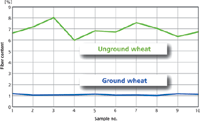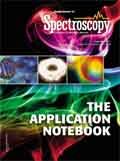Sample Preparation for NIR Analysis
Application Notebook
A much discussed issue related to near infrared analysis (NIR) is the necessity of sample preparation. Ground and unground samples of wheat were analyzed to determine how truly necessary it is to homogenize samples before NIR analysis. The new Retsch TWISTER mill, specifically designed for NIR sample preparation, was utilized for this comparative study.
A much discussed issue related to near infrared analysis (NIR) is the necessity of sample preparation. Ground and unground samples of wheat were analyzed to determine how truly necessary it is to homogenize samples before NIR analysis. The new Retsch TWISTER mill, specifically designed for NIR sample preparation, was utilized for this comparative study.
Feed quality decisively influences the productivity of livestock farming. However, high-quality forage considerably adds to costs of stock breeding. Consequently, economic considerations focus on quality and quantity of components used in the production process. This includes reliable analyses of feedstuff and ingredients from receipt of goods to final inspection as the best way to ensure a balanced feeding of livestock while keeping cost and profit orientation in focus.
Near infrared (NIR) spectroscopy is the most important analytical method for determination of protein content, moisture, fat, and ash in feeds and forage. NIR offers a quick method for analysis without the requirement of consumables or reagents. In order to utilize NIR effectively and efficiently, one must first consider the limitations of this analytical tool, especially regarding the samples to be analyzed.
Experimental Conditions
NIR analysis is sensitive to the homogeneity and analytical fineness as both of these characteristics can cause inaccurate readings due to inefficient scattering of light and detection from the analyzer. In order to demonstrate this phenomenon, samples of wheat were taken. The wheat material was divided into 10 samples of ground material and 10 samples of unground material.
The individual samples of wheat were processed in the TWISTER mill. The mill utilizes both friction and impact between the rotor and the abrasive surface of the grinding ring. The unit is designed for gentle but fast processing so that the feed material remains in the grinding chamber for a very short time, thus maintaining moisture content. The design of the mill uses a cyclone configuration that generates a vacuum jet of air that allows the sample to be pulled through the grinding chamber and collected into a sample bottle. This feature of the TWISTER allows the user to process sample-after-sample without cleaning the grinding chamber between runs.
The quantitative measurements were carried out with the NIR Spectrometer TANGO from Bruker GmbH (Billerica, Massachusetts).
Results
Test results, seen in Figure 1, illustrate the accuracy of analyzing homogenized wheat samples versus unground wheat samples. One detail to note is the significant deviations between each measurement of the unground sample, whereas, the ground wheat sample shows no significant statistical errors.

Figure 1: The analysis of the unground sample clearly shows a systematic and a considerable statistical error.
Conclusion
The general consensus for NIR sample preparation is that it is not necessary; however, from the results presented in this application study, this opinion needs revision. When considering sample preparation within the NIR analytical lab, the necessity of quick grinding processes and ease of cleaning is paramount. With Retsch's TWISTER mill, these requirements can be met, as well as the ability to provide a sample that is at analytical fineness and homogeneous. Only then is it possible to guarantee meaningful and reliable analytical results.
Retsch Inc.
74 Walker Lane, Newtown, PA 18940
tel. (866) 473-8724
Website: www.retsch-us.com

Thermo Fisher Scientists Highlight the Latest Advances in Process Monitoring with Raman Spectroscopy
April 1st 2025In this exclusive Spectroscopy interview, John Richmond and Tom Dearing of Thermo Fisher Scientific discuss the company’s Raman technology and the latest trends for process monitoring across various applications.
A Seamless Trace Elemental Analysis Prescription for Quality Pharmaceuticals
March 31st 2025Quality assurance and quality control (QA/QC) are essential in pharmaceutical manufacturing to ensure compliance with standards like United States Pharmacopoeia <232> and ICH Q3D, as well as FDA regulations. Reliable and user-friendly testing solutions help QA/QC labs deliver precise trace elemental analyses while meeting throughput demands and data security requirements.